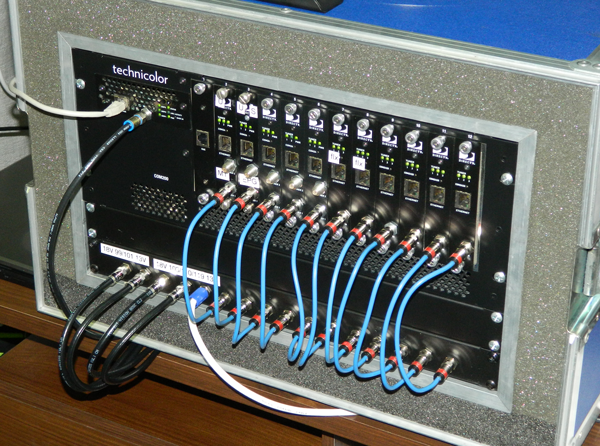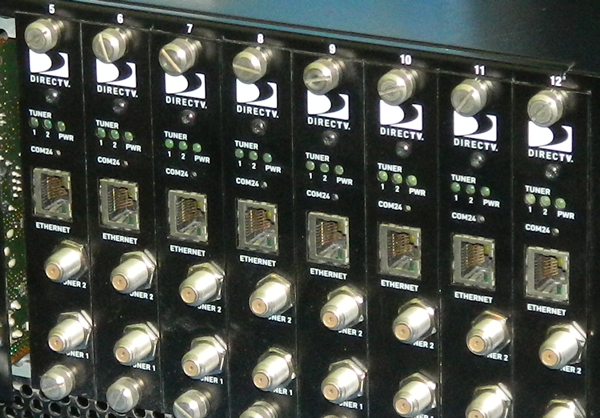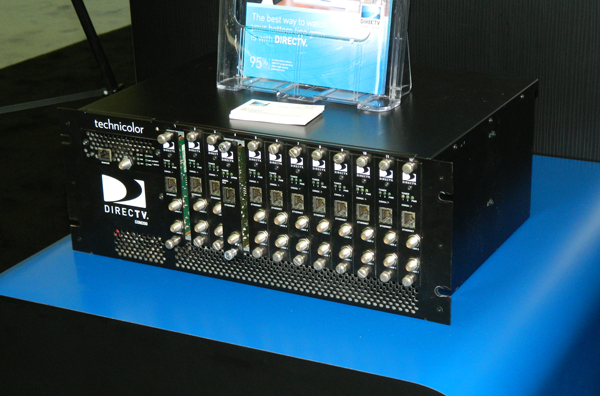At the HITEC show, I got to spend a little time with the folks at Technicolor, who make the COM1000 Free-to_Guest headend system for commercial installs. I learned a lot about why someone would want a system like this.

Technicolor is a name that makes us think of old Hollywood musicals, but it’s really a high-tech company with a long history. The new company is descended from the inventors of the color process used in 1940s and 1950s films, but they also have manufactured consumer equipment under several names including RCA and Audiovox, both names known to the US Market. The parent company is also the highest-volume manufacturer of DIRECTV receivers and DVRs. If you look at the model number of your equipment and it ends in -100, that’s Technicolor.
My first question was, Why COM1000? I mean, why not just stack up a bunch of H25 receivers?
The obvious answer is size. Look at the picture. You can actually replace up to 24 HD or 36 SD receivers with one COM1000. The unit itself takes up 4U of rack space. Just the receivers alone would probably take up 6U, and then of course they would just be stacked up on each other leaking heat.
Of course, once you had 36 H25s, you’d need a modulator for each one and that would probably be 36U of space. By now this would be a rack and a half full of equipment.

This is the COM1000 that Technicolor brought to the HITEC show. You can see how a multiswitch feeds all the different blades. Of course you wouldn’t see something like this in a road case in most installations.
When I began to dig into the real story about the COM1000, I saw there was more to it. For a smaller installation, COM1000 offers two really critical advantages.
First of all, unlike other systems, the COM1000 uses serial wiring. This is like the lights on a Christmas tree… one wire comes out of the COM1000 and splitters are used to feed individual TVs along the way. Whether it’s a big system like DIRECTV Residential Advantage or a smaller system with a matrix switcher, you usually have to run one wire from the rack to every TV. Obviously there is a cost savings in both installation and materials.
Second, the COM1000 system is unique in that it uses the PSIP system to put guide data about what’s on every channel right into the video stream. If you’ve ever been in a hotel room and you just want to know what’s on now… you’ll appreciate this. Guide information from the DIRECTV systems is passed along and when you tune to a channel you see a quick banner telling you about the program.

When it comes to features, I was pretty impressed. I thought that COM1000 was basically a compact system that combined receivers and modulators. I didn’t know there was another whole dimension to it.
High Definition signals must be encrypted. It’s not a law, but it’s part of every contract there is. There’s a lot of worry and concern that someone would come into a hotel room and record digital signals, which they would then send out over the internet. At that point the world would come to an end.
Ok, it sounds a little far-fetched, but believe it or not that’s how those guys think.
COM1000 gives you two ways to satisfy those pernicious content providers: Pro:Idiom and LYNK. Pro:Idiom is an industry-standard encryption system that’s built into commercial televisions. LYNK is a similar system developed by Samsung that’s designed for lower cost of implementation. COM1000 will handle both.
Not only that, COM1000 will stream to all the latest commercial TVs using category 5 cabling. This adds even more flexibility. All in all I was very impressed by what this system did.
You may be asking… what about DIRECTV Residential Experience? Think about it this way… there are work boots and dress shoes. Each has its place, and using the wrong one doesn’t really work. COM1000 offers value and ease of installation for 24 HD channels. DIRECTV Residential Experience is a super-powered system that gives up to 10 times more channels and DVR capability. There are other systems like the Floodgate 4000 that easily and inexpensively integrate multiple sources.
It’s all about choice and picking the system that suits you best!

